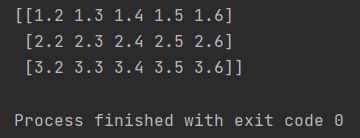Let’s learn how to get a column in a Numpy array. This is what allows you to manipulate data in the Numpy Python library.

In NumPy, multi-dimensional arrays are structured with axes. For a 2D array, axis 0 represents the rows, and axis 1 represents the columns.
We have such a Numpy array:
[1.1, 1.2, 1.3, 1.4, 1.5, 1.6, 1.7, 1.8, 1.9, 1.10], [2.1, 2.2, 2.3, 2.4, 2.5, 2.6, 2.7, 2.8, 2.9, 2.10], [3.1, 3.2, 3.3, 3.4, 3.5, 3.6, 3.7, 3.8, 3.9, 3.10]
How to get a single column?
How to get only the elements from the fourth column? Like that:
import numpy as np
my_array = np.array((
[1.1, 1.2, 1.3, 1.4, 1.5, 1.6, 1.7, 1.8, 1.9, 1.10],
[2.1, 2.2, 2.3, 2.4, 2.5, 2.6, 2.7, 2.8, 2.9, 2.10],
[3.1, 3.2, 3.3, 3.4, 3.5, 3.6, 3.7, 3.8, 3.9, 3.10]))
chosen_elements = my_array[:, 3]
print(chosen_elements)

chosen_elements = my_array[:, 3] selects all elements from the fourth column (index 3, as indexing starts from 0 in Python).
How to get one value from given column and row?
Keep moving further.
How to get elements from the second row and fourth column?
import numpy as np
my_array = np.array((
[1.1, 1.2, 1.3, 1.4, 1.5, 1.6, 1.7, 1.8, 1.9, 1.10],
[2.1, 2.2, 2.3, 2.4, 2.5, 2.6, 2.7, 2.8, 2.9, 2.10],
[3.1, 3.2, 3.3, 3.4, 3.5, 3.6, 3.7, 3.8, 3.9, 3.10]))
chosen_elements = my_array[1, 3]
print(chosen_elements)

chosen_elements = my_array[1, 3] returned second row and fourth column.
How to get multiple columns?
So, how do you get a lot of columns? Let’s get columns two through six.
import numpy as np
my_array = np.array((
[1.1, 1.2, 1.3, 1.4, 1.5, 1.6, 1.7, 1.8, 1.9, 1.10],
[2.1, 2.2, 2.3, 2.4, 2.5, 2.6, 2.7, 2.8, 2.9, 2.10],
[3.1, 3.2, 3.3, 3.4, 3.5, 3.6, 3.7, 3.8, 3.9, 3.10]))
chosen_elements = my_array[:, 1:6]
print(chosen_elements)

chosen_elements = my_array[:, 1:6] is returning columns second to sixth thanks to colon. A colon denotes a range of 1 to 6 columns, 2 to 6.
How to get every few columns
One more tip.
How to get many columns from a step? Let’s return to columns second to sixth, but every second column.
import numpy as np
my_array = np.array((
[1.1, 1.2, 1.3, 1.4, 1.5, 1.6, 1.7, 1.8, 1.9, 1.10],
[2.1, 2.2, 2.3, 2.4, 2.5, 2.6, 2.7, 2.8, 2.9, 2.10],
[3.1, 3.2, 3.3, 3.4, 3.5, 3.6, 3.7, 3.8, 3.9, 3.10]))
chosen_elements = my_array[:, 1:6:2]
print(chosen_elements)

chosen_elements = my_array[:, 1:6:2] as you can notice added a step. Another colon is doing that, and digit 2 tells how big the step is.
Now, you can get columns in Numpy arrays.
